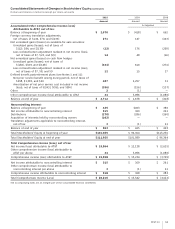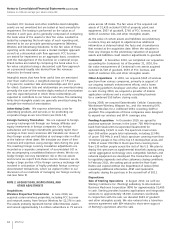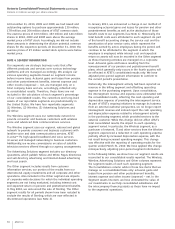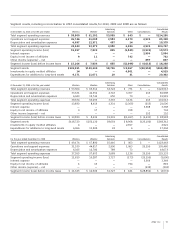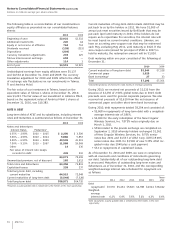AT&T Wireless 2010 Annual Report Download - page 68
Download and view the complete annual report
Please find page 68 of the 2010 AT&T Wireless annual report below. You can navigate through the pages in the report by either clicking on the pages listed below, or by using the keyword search tool below to find specific information within the annual report.
Notes to Consolidated Financial Statements (continued)
Dollars in millions except per share amounts
66 AT&T Inc.
We report, on a net basis, taxes imposed by governmental
authorities on revenue-producing transactions between us and
our customers in our consolidated statements of income.
Cash and Cash Equivalents Cash and cash equivalents
include all highly-liquid investments with original maturities of
three months or less. The carrying amounts approximate fair
value. At December 31, 2010, we held $332 in cash and
$1,105 in money market funds and other cash equivalents.
Revenue Recognition Revenues derived from wireless,
local telephone, long-distance, data and video services are
recognized when services are provided. This is based upon
either usage (e.g., minutes of traffic/bytes of data processed),
period of time (e.g., monthly service fees) or other established
fee schedules. Our wireless service revenues are billed either
in advance, arrears or are prepaid. Our wireless Rollover® rate
plans include a feature whereby unused anytime minutes do
not expire each month but rather are available, under certain
conditions, for future use for a period not to exceed one year
from the date of purchase. Using historical subscriber usage
patterns, we defer these revenues based on an estimate of
the portion of unused minutes expected to be utilized prior
to expiration.
We record an estimated revenue reduction for future
adjustments to customer accounts, other than bad debt
expense, at the time revenue is recognized based on historical
experience. Service revenues also include billings to our
customers for various regulatory fees imposed on us by
governmental authorities. Cash incentives given to customers
are recorded as a reduction of revenue. When required as
part of providing service, revenues and associated expenses
related to nonrefundable, upfront service activation and
setup fees are deferred and recognized over the associated
service contract period or customer life. Associated expenses
are deferred only to the extent of such deferred revenue.
For contracts that involve the bundling of services, revenue
is allocated to the services based on their relative fair value.
We record the sale of equipment to customers as gross
revenue when we are the primary obligor in the arrangement,
when title is passed and when the products are accepted by
customers. For agreements involving the resale of third-party
services in which we are not considered the primary obligor
of the arrangement, we record the revenue net of the
associated costs incurred. For contracts in which we
provide customers with an indefeasible right to use network
capacity, we recognize revenue ratably over the stated life
of the agreement.
We recognize revenues and expenses related to publishing
directories on the amortization method, which recognizes
revenues and expenses ratably over the life of the directory
title, typically 12 months.
Recent Accounting Standards
Fair Value Measurements and Disclosures In January 2010,
the Financial Accounting Standards Board (FASB) issued
“Fair Value Measurements and Disclosures–Improving
Disclosures about Fair Value Measurements” (ASU 2010-06),
which required new disclosures and explanations for transfers
of financial assets and liabilities between levels in the fair
value hierarchy. ASU 2010-06 also clarifies that fair value
measurement disclosures are required for each class of
financial asset and liability, which may be a subset of a caption
in the consolidated balance sheets, and those disclosures
should include a discussion of inputs and valuation techniques.
For financial assets and liabilities subject to lowest-level
measurements (Level 3), ASU 2010-06 further requires that we
separately present purchases, sales, issuances, and settlements
instead of netting these changes.
Revenue Arrangements with Multiple Deliverables In
October 2009, the FASB issued “Multiple-Deliverable Revenue
Arrangements” (ASU 2009-13), which addresses how revenues
should be allocated among all products and services included
in our bundled sales arrangements. It establishes a selling
price hierarchy for determining the selling price of each
product or service, with vendor-specific objective evidence
at the highest level, third-party evidence at the intermediate
level, and a best estimate at the lowest level. It eliminates
the residual method as an acceptable allocation method, and
requires the use of the relative selling price method as the
basis for allocation. It also significantly expands the disclosure
requirements for such arrangements, including, potentially,
certain qualitative disclosures. We adopted ASU 2009-13 for
sales entered into or materially modified in the year beginning
January 1, 2011. ASU 2009-13 had no material effect on our
financial statements or existing revenue recognition policies.
Employee Separations We established obligations for
expected termination benefits provided under existing plans
to former or inactive employees after employment but before
retirement. These benefits include severance payments,
workers’ compensation, disability, medical continuation
coverage, and other benefits. At December 31, 2010, we had
severance accruals of $848 and at December 31, 2009, we
had severance accruals of $669. During the fourth quarter
of 2010, we accrued $756 in conjunction with ongoing cost
reduction initiatives.
Income Taxes We provide deferred income taxes for
temporary differences between the carrying amounts of
assets and liabilities for financial reporting purposes and the
computed tax basis of those assets and liabilities. The tax
basis of assets and liabilities are based on amounts that meet
the recognition threshold and are measured pursuant to the
measurement requirement in current standards. We provide
valuation allowances against the deferred tax assets for which
the realization is uncertain. We review these items regularly
in light of changes in federal and state tax laws and changes
in our business.









